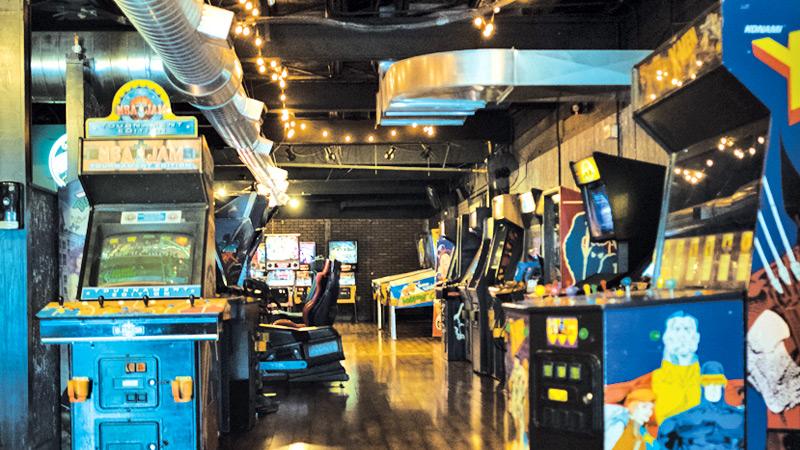
Arcades or as it is more formally known, Amusement Arcades, used to be a mainstay of public entertainment venues all around the world for decades.
At one point in time, it was the only feasible place kids and adults alike could afford to play video games at, and as result were hubs that entire communities could form around, brought together by their love of games.
Darkly lit rooms with rows upon rows of arcade cabinets all flashing and beeping drowned out by the excited crowds of children and teenagers; arcades held a unique atmosphere that nothing else like it could replicate since.
Over time however, arcades declined, fading into the background, rarely ever existing outside of memories or media attempting to stir up nostalgia for a time long past. Whatever happened to arcades? And is there any sign of them making a comeback?
Origins
Arcade games have a rich history that stretches back through time. The origins of arcades can be traced to the 19th Century, when midways, dime museums, and amusement parlours provided patrons with novel attractions.
These establishments featured arches supporting their roofs and recessed arches for various attractions, giving rise to the name “arcades.” Visitors could spend their dimes and quarters on early forms of entertainment like kinetoscopes and phonographs, offering the miraculous experience of recorded sounds and moving images.
Over time, these attractions evolved, catering to a wider audience with coin-operated shooting galleries, peep shows, fortune tellers, and even early slot machines.
The arcade scene saw a transformative moment in 1931 by David Gottlieb’s Baffle Ball introducing the concept of a “pin game”, later more popularly dubbed as pinball games.
These games gained instant widespread popularity, later incorporating flippers and bumpers. While there were concerns from some groups about their association with gambling and delinquency, arcades continued to thrive.
By the mid-1970s, the short lived ban on pinball machines was lifted, making them a common sight in various establishments. This era also saw the emergence of electromechanical predecessors to video games, using belt-driven discs and projector screens to simulate thrilling experiences.
Coin-operated video game
In 1971, the first coin-operated video game, Galaxy Game, based on Space War, was installed at Stanford University. Shortly after, ‘Computer Space’, a simpler version of a multi-directional shooter, became the first commercially available arcade game. Nolan Bushnell and Ted Dabney, creators of ‘Computer Space’, founded ‘Atari’ and went on to develop ‘Pong’, the first successful coin-op arcade game.

‘Space Invaders’, released in 1978, marked a turning point for arcade games. It propelled video games into the mainstream, causing coin shortages in Japan and influencing global pop culture.
This success was followed by other hit games like ‘Galaxian’ and ‘Asteroids’. The late 1970s and early 1980s were characterized by the rise of video arcades across continents, sparking the golden age of video games.
The 1980s witnessed a wave of iconic games like ‘Pac-Man’, ‘Defender’, ‘Centipede’, and more. However, the arcade market became saturated with imitations, leading to the Great Video Game Crash of 1983, which affected arcades and video game consoles to varying extents. Similar to how the oversaturation of third party shovelware games flooding the console market caused a cascade effect that killed public interest in console games in favour of personal computers, arcades were also saturated with more games than there were players.
Second generation
Most arcades shutdown with no way to turn a profit anymore, effectively killing the arcade industry.
Once the second generation of video games revived the industry, the remaining arcades were slow to adapt. Arcade games had once offered superior experiences compared to home consoles, but the landscape changed with the new 8-bit era.
Console exclusives like ‘Super Mario Bros.’ and ‘The Legend of Zelda’ provided deeper and more immersive experiences. While console games embraced expansive game design, arcades focused on communal multiplayer experiences and cutting-edge graphics.
Though arcades had a resurgence in the 1990s with hits like ‘Street Fighter’, they declined again with the rise of arcade-quality home consoles. They returned to their earlier role as additional revenue sources for various venues. In recent years, there has been a revival of retro arcades aiming to recreate the nostalgia of the past.
Enduring appeal
These arcades offer a way to experience classic games and a unique gaming environment, catering to both old and new fans.
In recent years, the Internet Archive’s creation of the Internet Arcade, featuring over 900 classic games playable in-browser, has aimed to rekindle interest in older arcade games. This archive serves as a testament to the enduring appeal of arcade games, bridging the gap between the past and present.
There is also a niche trend of home arcades, with some nostalgic arcade fans owning their own arcade machines for personal use.
The arcade landscape varied in different parts of the world, and in some cases still thrive to this day.
In the UK, arcades were popular until the mid-1990s, when the shift to 3D graphics raised prices beyond what young players could afford. In Japan, arcades remained popular, giving rise to unique genres and standardized arcade hardware. Japanese arcades also pioneered revenue-sharing models that allowed them to remain profitable in spite of the popularity of console games over arcades.
